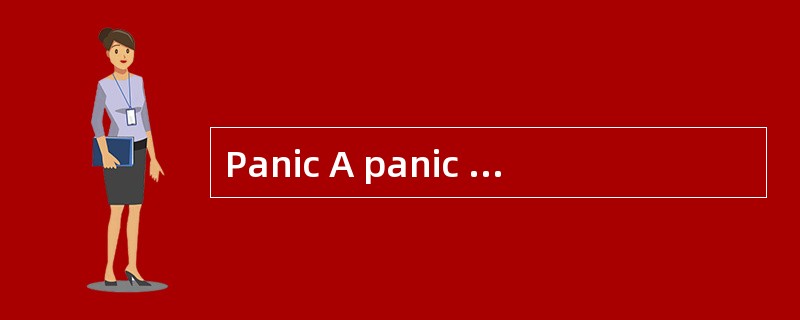Panic A panic is aform of collective in which a group of people,face with an immediatethreat,re-act in an uncoordinated and irrational way.Their behavior isuncoordinated
in the sense thatco-operative social relationships and break down.It is irrational in the sensethat people's actions are not appropriate for the goals they wish to achieve.The
progress of a panicfollows a fairly typical course . A sudden crisis occurs;people experi- enceintense fear;normal social expectations are broken;each individual tries
desperately to es-cape from the source of danger;mutual cooperation breaks down;and the situationbecomes even more threatening as a result. Panics are especially likely to
occur in unusualconditions in which everyday norms have little relevance,such asfires,floods,earthquakes or military invasions. Some kind of response isnecessary in these
situations, butthere are few social norms that specify an appropriate reaction.Thus,when apassenger aircraft makes a crash landing people may at-tempt to flee beforefire
breaks out and causean explosion,but there only succeed in stopping themselves and others bycreating bottlenecks at the exits.Awareness of bottlenecks may lead to
increased panic,withpeople fighting and trampling one another in the effort to escape.Despiteintensive training of airline personnel in emergency evacuation procedures,a
high proportion ofpassenger deaths are caused by a panic that prevents people from escaping intime. The most dramatic panics are those that occur in situations of extreme
emergency,but notall panics are quite so frantic or short-lived.A different form of this collectivebehavior is the finan- cial panic,which is typically provoked by rumor that
the price of stockswill fall or that a bank will be unable to repay its depositors .The classicexample,of course, occurred at the outset of the Great Depression in 1929:as in
other forms ofpanic,the individuals involved tried to protect their own interests,and in sodoing they worsened the situation for themselves and everyone else. By tryingto
sell their stocks asquickly as possible,people ensured that the price of stocks did fall;bydemanding their money back from banks,they ensured that the banks actually didcol-
lapse.
What is thepurpose of the passage?
A.To analyze thecauses of the panics and teach people how to prevent them.
B. To introducedifferent kinds of panics.
C. To help peopleset up daily norms that can prevent panics.
D. To inform peopleof painful examples form panics.
参考答案与解析:
-
相关试题
-
Panic A panic is aform of collective in which a group of people,face with an immediatethreat,re-act
-
[单选题]Panic A panic is aform of collective in which a group of people,face with a
- 查看答案
-
Panic A panic is aform of collective in which a group of people,face with an immediatethreat,re-act
-
[单选题]Panic A panic is aform of collective in which a group of people,face with a
- 查看答案
-
Panic A panic is aform of collective in which a group of people,face with an immediatethreat,re-act
-
[单选题]Panic A panic is aform of collective in which a group of people,face with a
- 查看答案
-
Panic A panic is aform of collective in which a group of people,face with an immediatethreat,re-act
-
[单选题]Panic A panic is aform of collective in which a group of people,face with a
- 查看答案
-
That scientists havecloned a sheep sends academics and the public into a panic at the prospect thath
-
[单选题]That scientists havecloned a sheep sends academics and the public into a pa
- 查看答案
-
That scientists havecloned a sheep sends academics and the public into a panic at the prospect thath
-
[单选题]That scientists havecloned a sheep sends academics and the public into a pa
- 查看答案
-
That scientists havecloned a sheep sends academics and the public into a panic at the prospect thath
-
[单选题]That scientists havecloned a sheep sends academics and the public into a pa
- 查看答案
-
That scientists havecloned a sheep sends academics and the public into a panic at the prospect thath
-
[单选题]That scientists havecloned a sheep sends academics and the public into a pa
- 查看答案
-
That scientists havecloned a sheep sends academics and the public into a panic at the prospect thath
-
[单选题]That scientists havecloned a sheep sends academics and the public into a pa
- 查看答案
-
Don't get panic!Ihave made preparation [in advance.]
-
[单选题]Don't get panic!Ihave made preparation [in advance.]A.predictablyB.wiselyC.
- 查看答案
